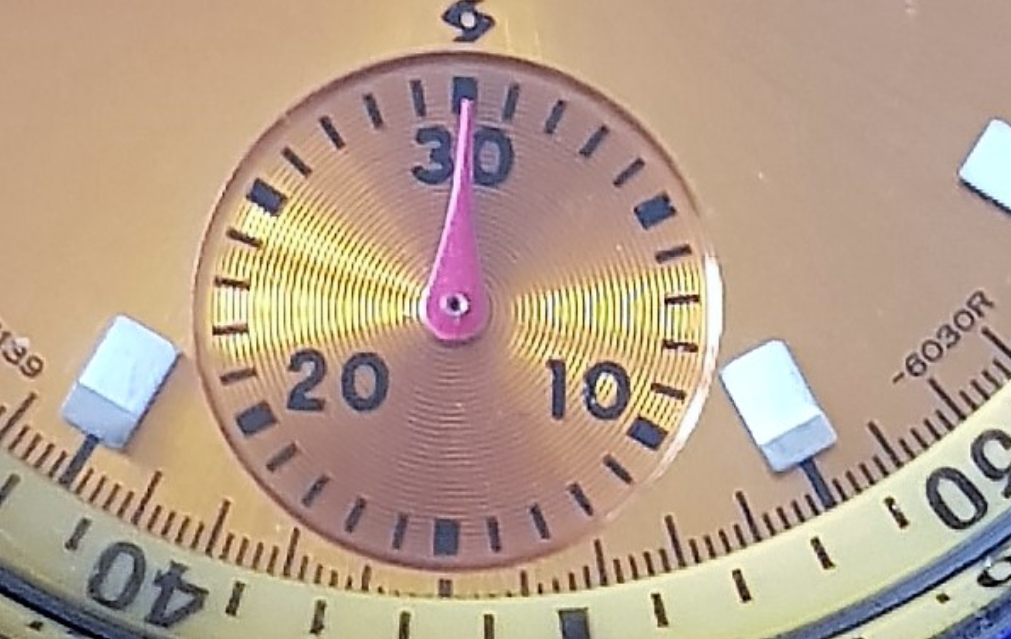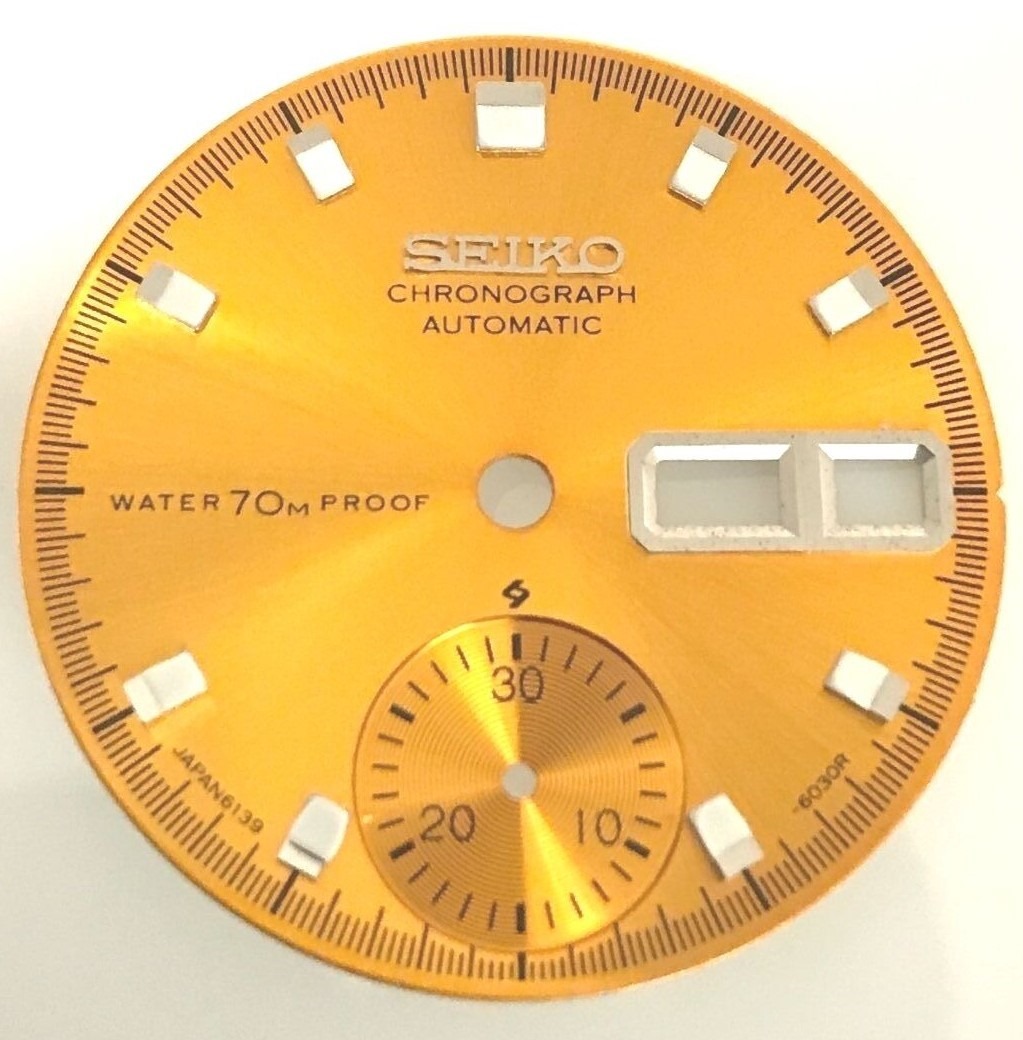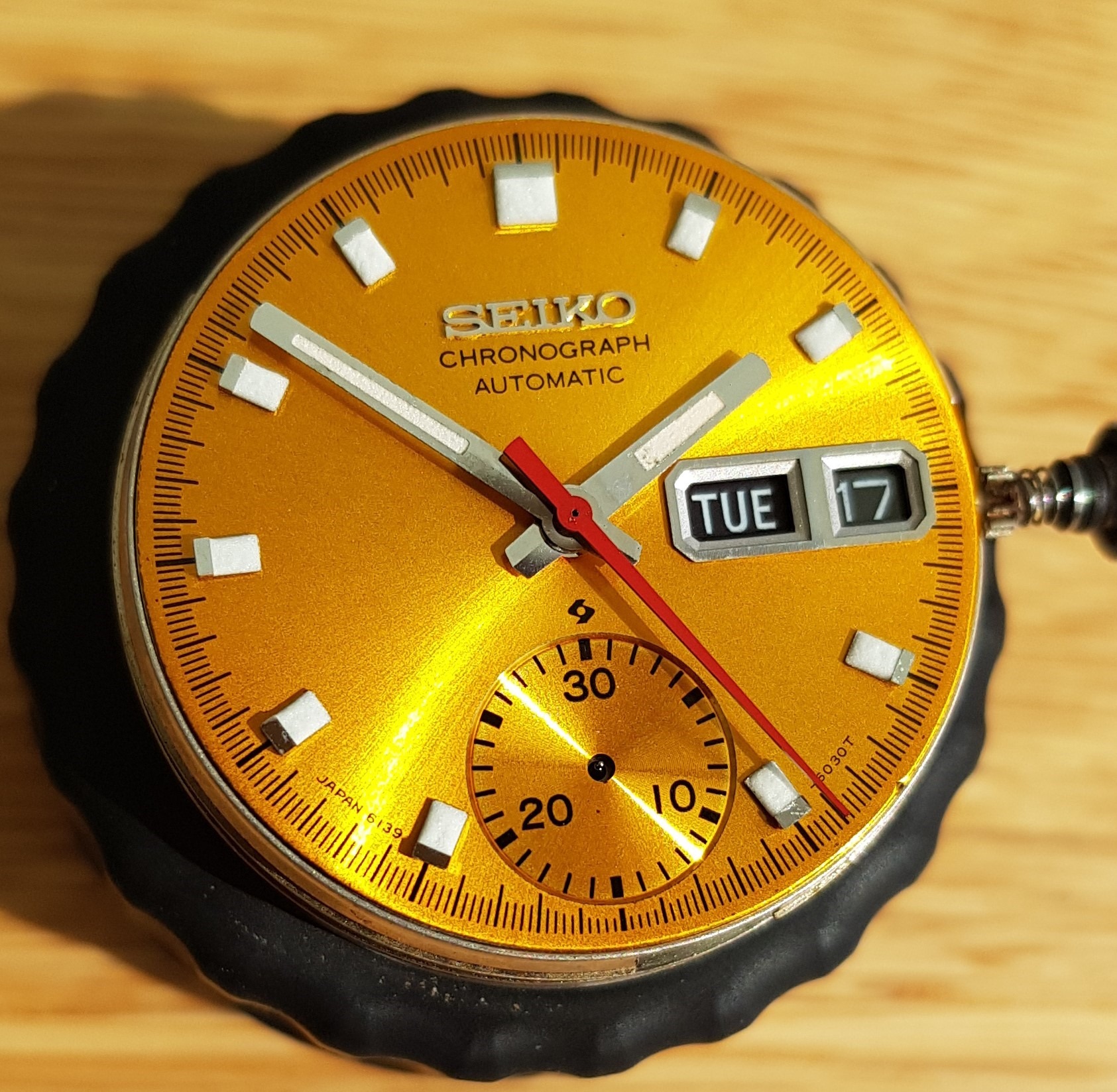Another post on spotting the differences between Seiko Pogue dials. First to understand what is fake, we need to understand what is real.There are numerous variants of dial used throughout the production period of the mainstream 600x range, but they can broadly be broken down into colours of Yellow (or Gold), Blue (or Black) and Silver. There are other variants of JDM-only dials which we’ll come back to later.
Within the 3 colours, again leaving aside SpeedTimers and other JDM watches, there were two main layout variants: the US-market watches which said only AUTOMATIC under the SEIKO logo, and the rest which said CHRONOGRAPH and AUTOMATIC. The former (2-line) dials are referred to on the lower right as -6009 and the 3-line dials are reference -6030.
Following the reference, there is a T or R specification – little is known about when or why Seiko chose to mix the two, but subvariants of both 6009 and 6030 dials appeared alongside each other. Both variants are observed on watches marked WATER 70m RESIST and watches with no markings (but WATER 70M PROOF watches have only been seen with T dials), and both T and R dials were produced fairly late into the cycle (1976 or even after).
Side by side comparison – both 70m RESIST 6139-6002s, the R dial on the left from 1972 and the T-dial from 1971. Both have English/French day wheels.
It appears that T dials were the most prevalent until 1972, and R dials the most numerous afterwards, but authentic watches with T dials have been seen up to ‘76.
Genuine vs aftermarket
Generally speaking, aftermarket dials will look OK in a grainy eBay photo but in hand, compared side by side with a real one, it’ll be obvious they’re different. Things to look out for:
- The majority of fake dials are 6030R branded. If you see a PROOF marked dial that’s 6030R, it’s almost certainly hookey.
- Again, PROOF and RESIST marked dials should be on early watches – certainly on or before 1972, so if you see a PROOF marked dial on a watch whose serial number starts 7xxxxx then it’s wrong. Also, the –6009 generation dials didn’t ever have PROOF – they were all RESIST or nothing.
- A genuine dial will have a 2-digit code printed or etched on its rear – the same 2 digits as the serial number of the case starts with, or close. Obviously, you can’t see them without taking the whole thing to bits, but if you are looking at photos of a watch which has been serviced and you can see the backside of the dial, it could help to assure you that the dial is original.
- If you’re getting your watch serviced, ask your watchmaker to take a photo of the back of the dial for the sake of provenance.
- NB: the numbers can be one or two months out – eg a Nov 69 watch with 9N serial number could have 99, 90, 9D or even 01 printed on the dial, depending on when the dial was made and married to the watch itself.
- The aftermarket dials often have a pronounced concentric circle arrangement on the subdial – there is a subtle sunburst on the real subdials but nowhere near as obvious.

Fake dial from 2016 eBay watch

Aftermarket “Seikosis” dial, from eBay 2019
The “T” dials – characteristics
The T suffix dials tend to be more subtle – the sunburst effect on yellow watches in particular is less noticeable, and the colour is lighter than the R dials when placed side by side.
There is a slight gap between “JAPAN” and “6139”, sitting just above the 37 minute marker, and the As in JAPAN have a flat top. The dial code on the right side starts with a dash just above or slightly to the right of the 24 minute marker.
This example is from a -6002 watch from 1976, 6030T dial (so no RESIST), that had a English/French day wheel.
Here’s a black/blue dial example, from a -6000 from 1970 (with PROOF dial) and English/Roman day wheel
A rare July 1969 silver PROOF/PROOF -6000, with English/Chinese day wheel.
The A and P of JAPAN sit above the 38 minute marker, though on yellow dials the alignment appears to be slightly different to blue and silver (where A is closer than P to the marke. The placement of the preceding dash of the dial code above the 24 minute mark also differs slightly, where on yellow dials it is slightly to the right but on blue and silver is directly above.
Pogue’s own watch shows both of these attributes – the flat As in JAPAN, the gap between it and 6139, placement above the 38 marker and the – 6009T slightly to the right of the 24.
The “R” dials – characteristics
The gap between JAPAN and 6139 that exists in the T dial is not there, or not so notable, and the As are pointed. The A /P sits above the 38 minute marker and the 6 sits above 37 minutes.
This example is from a -6002 watch from 1975, 6030R dial, that had a English/French day wheel.
Bllue R-dial from 1972
A silver R dial watch bought on eBay in 2017, but arrived damaged so was returned.
The 60 of the dial code sits above the 23 minute marker so further to the right than on T dials.

How about the Coke speedtimers? Do you have any tips for that?
[…] where the AD was used to denote the applied metal dial markers. The T (and if you follow this site, you’ll know about the T and R dials on Pogues) is now thought to mean that the dial was either made at or made for the Suwa factory. If that is […]
[…] a 6139B movement inside. All of the previous watches had 6030T dial markers at the bottom right – see more on the significance here – but this one is not only a late “RESIST” model (the 9 o’clock text went away in mid/late […]
With a 100% known from new watch, it is possible that the 2 numbers on the rear of the dial do not precisely match the first 2 of the serial number. The first digit (year) will most likely match but the second (month) can be 1 or 2 months before or after the serial numbers.
Yes, that’s right – a good point, I’ve updated the post to clarify. Thanks!
hi is it normal that a seiko pogue have a balck second hand?
No, it’s usually red or orange…
Hi I have a question about my SEIKO 6139 6002. I have had it new since 1979 but it appears to have different hands to all the others I have viewed on line. Both hour and minute hands have a break within the luminous paint, where as the others have one continuous line of luminous paint. It is the R version.
Have you come across this before?
I haven’t seen hands on 6139-600x that have segments for lume, but I think there are some on other Seikos of a similar era (though I can’t find photos of them quickly). Is it possible your watch was serviced in the past and had then hands swapped over? Send me a photo [ewan@vintagewatchadvisors.com]!?